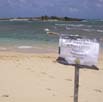 |
| HOME > Field Accounts |
ISLET FIELD ACCOUNTS
Follow the interns and volunteers through their work on the offshore islets. Click on the photos to link to a photo gallery for each visit.
|
|
> 19 Feb 2007: Moku'au'ia (Goat Island), O'ahu
> 29 Feb 2007: Mokulua, O'ahu
> 28 Mar 2007: Kaohikaipu (Black Rock), O'ahu
> 2-3 April 2007: Po'opo'o, Lana'i
> 2-3 April 2007: Pu'u pehe (Sweetheart Rock), Lana'i
> 5 Apr and 7 Apr 2007: Moku'au'ia (Goat Island), O'ahu
> 5-7 Apr 2007: Mokoli'i (Chinaman's Hat), O'ahu
> 29 Apr 2007: Kapapa (Mokukapapa), O'ahu
> 3-4 May 2007: Lehua, Kaua'i and Ni'ihau
> 9 May 2007: Moku'au'ia (Goat Island), O'ahu
> 12 May 2007: Mokoli'i (Chinaman's Hat), O'ahu
> 29-31 May 2007: Molokini, Maui
> 29-31 May 2007: Kaemi, Maui
> 29-31 May 2007: Hulu, Maui
> 1 Jun 2007: Moku'au'ia (Goat Island), O'ahu
> 8 Jun 2007: Moku'au'ia (Goat Island), O'ahu
> 15 Jun 2007: Moku'au'ia (Goat Island), O'ahu
> 22 Jun 2007: Moku'au'ia (Goat Island), O'ahu
> 29 Jun 2007: Moku'au'ia (Goat Island), O'ahu
> 6 Jul 2007: Moku'au'ia (Goat Island), O'ahu
> 18 Jul 2007: Moku'au'ia (Goat Island), O'ahu
> 24 Jul 2007: Moku'au'ia (Goat Island), O'ahu
> 31 Jul 2007: Moku'au'ia (Goat Island), O'ahu
> 7 Aug and 30 Aug 2007: Kapapa (Mokukapapa), O'ahu
> 7 Aug and 30 Aug 2007: Kaohikaipu (Black Rock), O'ahu
> 8 Aug 2007: Moku'au'ia (Goat Island), O'ahu
> 17 Aug 2007: Moku'au'ia (Goat Island), O'ahu
> 17 Aug 2007: Mokoli'i (Chinaman's Hat), O'ahu
> 24 Aug 2007: Moku'au'ia (Goat Island), O'ahu
> 8 Sep 2007: Mokauea, O'ahu
> 10 Sep 2007: Moku'ae'ae, Kaua'i and Ni'ihau
> 18-20 Sep 2007: Mokapu, Moloka'i
> 18-20 Sep 2007: 'Okala, Moloka'i
> 21 Sep 2007: Mokoli'i (Chinaman's Hat), O'ahu
> 22 Sep 2007: Moku'au'ia (Goat Island), O'ahu
> 24 Sep 2007: Kaohikaipu (Black Rock), O'ahu
> 24 Sep 2007: Manana (Rabbit Island), O'ahu
> 14-16 Oct 2007: Mokoli'i (Chinaman's Hat), O'ahu
> 17 Oct 2007: Popo'ia (Flat Island), O'ahu
> 20-21 Oct 2007: Kapapa (Mokukapapa), O'ahu
> 25 Oct 2007: Moke'ehia, Maui
> 26 Oct 2007: Mokupipi, Maui
> 27 Oct 2007: Pu'uku (Pu'uki'i), Maui
> 1 Nov 2007: Po'opo'o, Lana'i
> 1 Nov 2007: Moku mana, Maui
> 2 Nov 2007: Pu'u pehe (Sweetheart Rock), Lana'i
> 2 Nov 2007: Ki'ei, Lana'i
> 10 Nov 2007: Mokauea, O'ahu
> 1-2 Dec 2007: Kaohikaipu (Black Rock), O'ahu
> 9 Feb and Feb 11 2008: Manana (Rabbit Island), O'ahu
> 15 Feb 2008: Mokuho'oniki, Moloka'i
> 16 Feb 2008: Moku manu, Moloka'i
> 16 Feb 2008: Kanaha, Moloka'i
> 19 Mar 2008: 'Alau, Maui
> 20 Mar 2008: Mokuhuki, Maui
> 26 Mar 2008: 'Ale'ale, Kaho'olawe
> 26 Mar 2008: Pu'u koa'e, Kaho'olawe
|
|
Moku'au'ia (Goat Island) 15 Jun 2007
|
|
Trip Goal: To assist DOFAW biologists in an attempt to eradicate Yellow Crazy Ants from the islet using Mokoli'i Islet as a control (no bait used). Using the results of our bait preference trials, a new bait was made specifically for controlling Yellow Crazy Ants in Hawai'i. This ant species has disrupted seabird colonies and ecosystems elsewhere in Hawai'i and around the tropics, but eradication has been troublesome. A successful eradication on Moku'auia would be great step in restoring these fragile island ecosystems to their natural state. Accomplishments: Over the course of 3 months, we completed 2 ant bait applications and conducted intensive monitoring of the ant and seabird populations. We were able to significantly reduce ant numbers, but not eradicate them entirely. However, as a result of our experiment, seabirds were able to survive and successfully hatch chicks on the island. No seabird chicks survived on our control islet (Mokoli'i), where ant bait was not applied. More importantly, we have learned from the project and will readjust the bait amounts and timing and will hopefully eradicate the ants soon.
|

Photo Gallery
|
Intern Account: Kim:
"This trip was distinguishable in comparison with the other trips because there were Wedge-tailed Shearwaters (a seabird) sitting out in the open. These birds would usually hide in underground burrows or sit under the brush, however, there were about ten birds sitting out in the sun. When we walked past them, we thought that their vision was altered. We guessed ants may have attacked them and sprayed their eyes with some toxin, which ultimately tainted their vision. A couple birds were frightened by us and as they tried to escape they bumped into the brush and it was evident that they were disoriented. Also, for the first time, we started noticing that there were eggs out in the open, seemingly abandoned by their parent birds. In terms of the ants on this trip, we noticed a decrease in their numbers. During our transect walk-through of the islet, I found less ants present in my area. Also, while conducting our plot check, we only found around 100 ants in the major nest we found in the weeks prior. This was a good sign and I believe this nest should really continue to diminish within the next few weeks."
|
|
|

